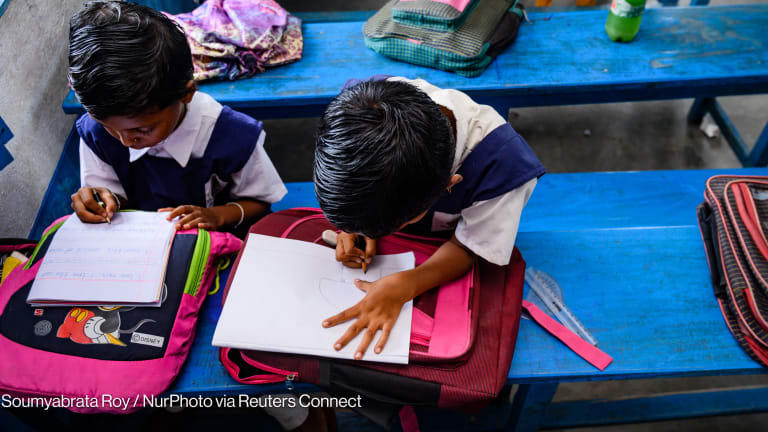
If the Millennium Development Goals and its successor are the “what” of development, the Global Partnership for Effective Development Co-operation, celebrating its first high-level meeting this week, is the “how.”
Officials from 161 governments and 54 organizations have gathered in Mexico City to debate ways to improve aid. One of the items on the agenda is transparency — and on that issue the way forward is obvious, according to David Hall-Matthews, director of Publish What You Fund, a London-based nonprofit that advocates for more and better information about aid.
All aid providers, Hall-Matthews asserted, must publish their data on the International Aid Transparency Initiative registry, so donors are held accountable for their promises and actions.
“There’s simply no other way,” he explained in an exclusive interview with Devex in which the head of PWYF also discussed the goal for donors to publish to IATI by 2015, how the GPEDC is tracking their spending, why publishing data ultimately benefits everyone, and the need for traditional donors to set an example to emerging aid providers.
Below are more highlights from our conversation with Hall-Matthews:
Transparency is on the agenda this week — does this mean it is now being sufficiently prioritized within the overall effectiveness agenda?
If the GPEDC is going to be a good, effective, meaningful organization, it has to demonstrate that it takes transparency and accountability really seriously. I’m encouraged that they’re talking about the “how,” rather than just the “what.” But there is no shilly-shallying about that — the only way to deliver [on transparency commitments] is for all aid providers to publish fully to IATI. There’s simply no other way you can get the timeliness, the detail, the comparability — which are what the common, open standard promises were about. What I’d really like to see is concrete promises about exactly what they’re going to do when. And I’d like to see the GPEDC itself pushing donors, in particular traditional aid donors, to do that — and then perhaps try to nudge, rather than push, other types of agencies, whether South-South or private sector partners to move in that direction as well.
So traditional donors should be the first target?
Yes. It is unreasonable to go to new, emerging donors or to private organizations that have very different accountability systems, and say, “do this” when donors have known they needed to do this, for at least 10 years, and have promised to do it. If they haven’t done it, why should anybody else? This is a flat global partnership — the first time there’s been a body that doesn’t have a top-down donors-telling-recipients-what-to-do structure. So if donors don’t stick to their side of the bargain, I don’t expect any other level [to do so].
Should there be penalties? Or how else do we get organizations to do what they have promised?
It’s difficult to talk about penalties because these are all voluntary commitments. But I would like to see the GPEDC being a bit tougher on really effective, robust monitoring. The [most recent] monitoring report demonstrated quite how badly most donors were doing. But it was nowhere near strong enough in the first place — they weren’t asking enough tough questions ...
When we have really pushed some major agencies to publish better data, it has turned out that their own systems are really messy. They’re old-fashioned, they don’t have accounting systems matching with those in their country offices — they don’t have enough internal transparency to make their own strategic decisions effectively, quite apart from sharing it. So our ask, which is a small, technical ask — to publish what you have in a comparable, machine-readable format — becomes a very big ask.
They have known their systems are poor for at least a decade, and that they will have to invest in improving them. We are asking them to basically set up whole new IT systems. But if they go down that road it should be very easy and more or less cost-free to add the update that everything should come back out again in IATI format ... We’re talking about something that would make life easier. You can use IATI data for all kinds of things, including DAC reporting requirements, country-specific reporting requirements, or any other requirement from parliament or other agencies. We always say “publish once, use often.”
Are there some particularly good practices among donors that stand out?
There are half a dozen agencies that are doing really well — from small, young agencies like the Millennium Challenge Corp. to huge, old agencies like the U.N. Development Program. If they can do it, given their various constraints and challenges, literally anybody can, if they want to.
Everybody that comes in the top 6 or so of our index is doing a good job — and they’re doing it in different ways. We’re really impressed with DfID: they’re very transparent and have been for some time, but they are also pushing that information out there, on their development tracker, which makes everything they publish to IATI [not only] available to the British taxpayer and anyone else, but also goes down the important road of traceability.
One of the big problems with transparency is that some major agencies give most of their money to other agencies to implement. DfID is in that camp, and has said to NGOs: “If we give you that money, we want to see you publish what you do with that money to IATI.” Additionally, they’ve done a pilot which has involved 7 or 8 private sector subcontractors starting to publish to IATI — a really good example of making sure that data gets linked up, [so] that you have traceability down the delivery chain. The Netherlands and Sweden, with public-facing, IATI-fed websites, are also taking steps in the right direction.
But is the information then being used effectively? Who is actually looking at it?
Obviously the ultimate goal is to have citizens in partner countries using the information as a tool to hold their governments to account. But for the moment … if you get aid from Italy or Japan, you won’t see it, if you get money from USAID you might or might not see it, because their publication is very partial, and France is only publishing to IATI in relation to Mali … I maintain my applause for DfID, even if most people using [its development tracker] are probably U.K. taxpayers and also other donor agencies. Aid coordination and harmonization were always impossible without transparency. Now that we’ve got a real critical mass of major donors starting to publish to IATI, I would say for the first time … it’s possible to start talking about harmonization and coordination — which people said they’d do back in 2005.
So the U.K. is doing well — but should it be doing more? Should it, for instance, do more to influence others?
I don’t see why DfID couldn’t offer help in a friendly way. They’ve been through the implementation hurdle. I would like to see them saying: “Look, we’re really good at this transparency thing,” and “Hey France, hey Japan, hey Italy, hey rest of the G-7 — come on board.” It’s a pretty serious issue when among the G-7 countries, Italy has done nothing, Japan has done nothing, France has only just started. The U.S. and Canada are very committed in principle, but the U.S. — a key player, since in volume it’s always going to be the biggest donor — is really struggling to implement it fast enough.
There’s not much time left to reach the end of 2015 targets on transparency. What should other implementers and partners be doing now?
Private sector and NGO partners didn’t make any promises in Busan — it was basically the OECD.
Most British NGOs do publish to IATI, because they take money from DfID. Most other NGOs don’t. I would really like to see American and [continental] European NGOs come in, not seeing IATI as a threat so much as an opportunity. I would have thought international NGOs would be the first to find it useful — to find out what is going from where to where and for what purpose. In terms of [addressing] overlap and coordination, NGOs have at least as big a job to do as bilateral or multilateral agencies.
In terms of private sector partners, I think we are only really talking about subcontracting for the moment, though it would be nice to talk about a new standard for CSR, for example. For now, for subcontractors who are spending [donor] money — it’s up to the agencies to make it a standard part of their contracting — so, if you take our money you will have to publish it to IATI. This would be relatively easy to roll out, easier than persuading disparate types of companies to publish data [after contracts are signed].
Finally, what would be the ideal outcome of this week’s meeting?
An absolute bare minimum is a roadmap on how everybody is going to fulfil the common standard by the end of 2015. But the ideal would be to push further and talk about how we’re going to improve the quality of transparent data: how we are going to make sure that the information is more detailed, more accurate, more timely, and also more forward-looking? It would fantastic if this high-level meeting concludes that we are going to fulfil the 2015 commitment — and then make another 2016 commitment, not just to do more, but to do better.
See more:
GPEDC high-level meeting opens in Mexico City
GPEDC high-level meeting to push Busan agenda even further
3 tests for the Global Partnership
Financing the future: Why domestic revenue mobilization belongs on the post-2015 agenda
Boosting economic development: Real aid to the private sector
We must seize the opportunity of the First High-Level Meeting of the Global Partnership for Effective Development Cooperation
Read more development aid news online, and subscribe to The Development Newswire to receive top international development headlines from the world’s leading donors, news sources and opinion leaders — emailed to you FREE every business day.








